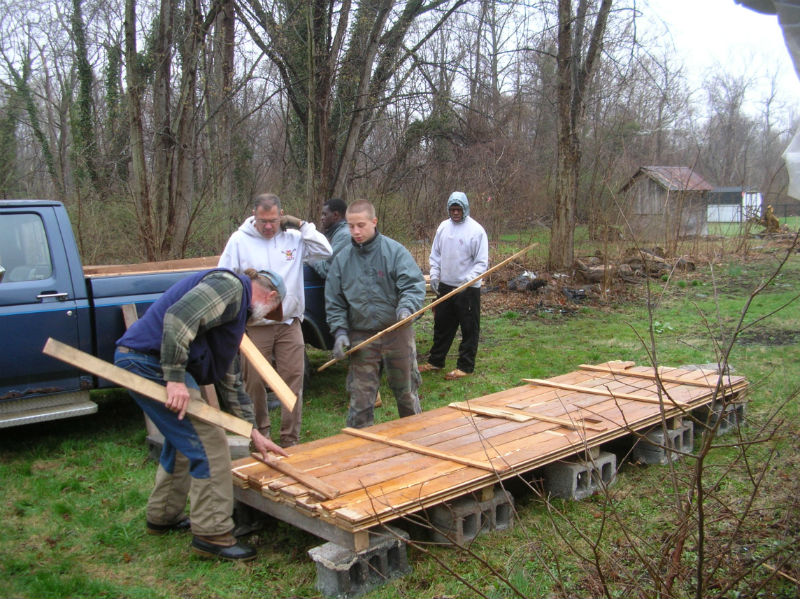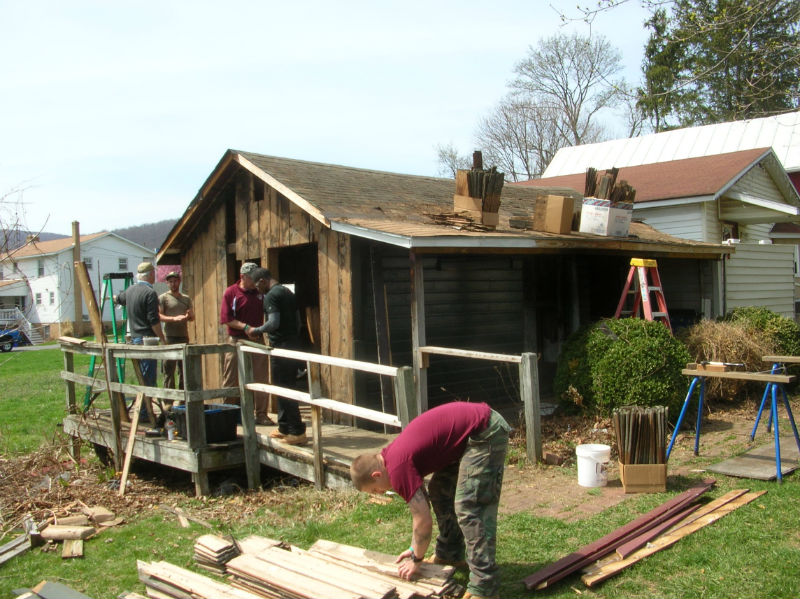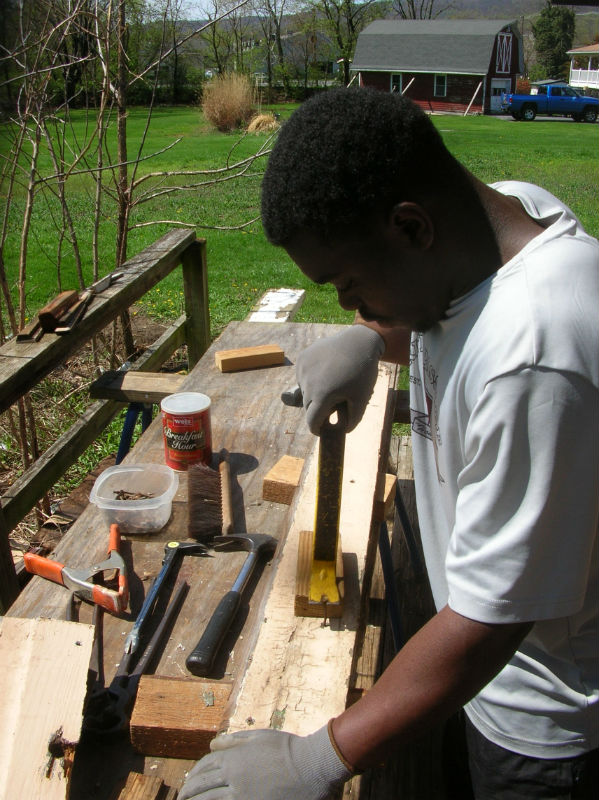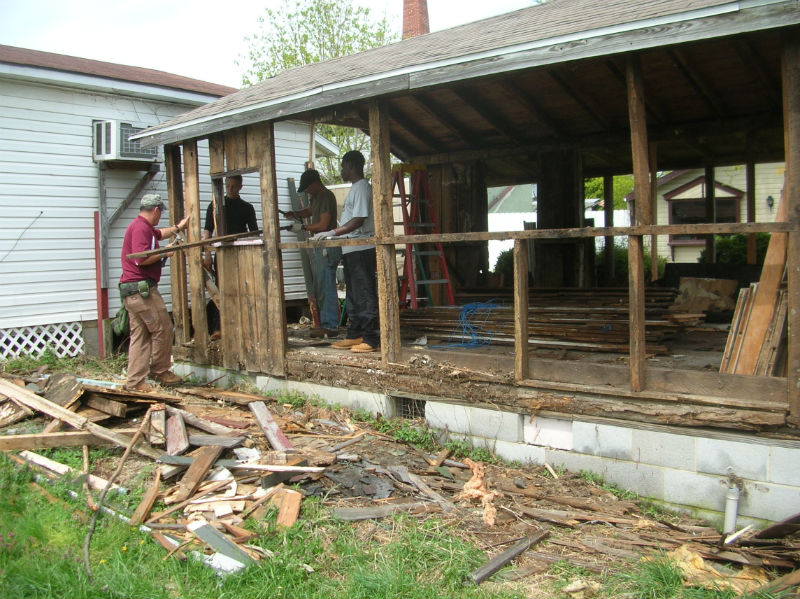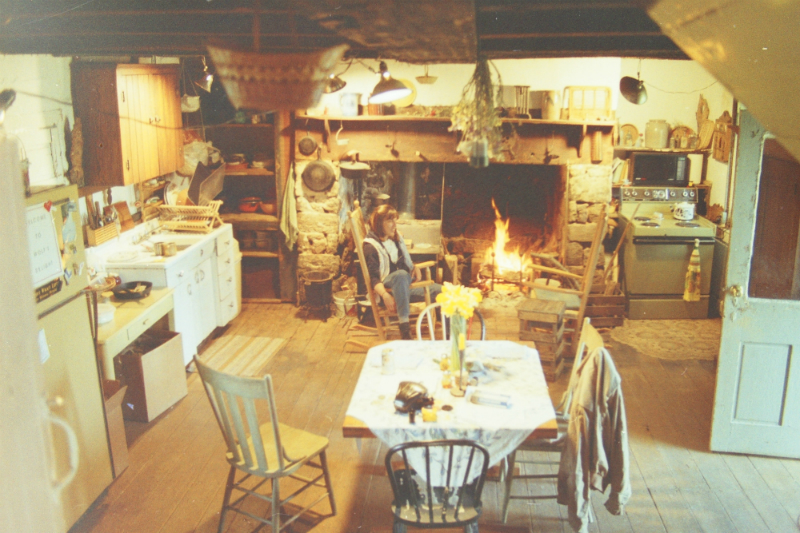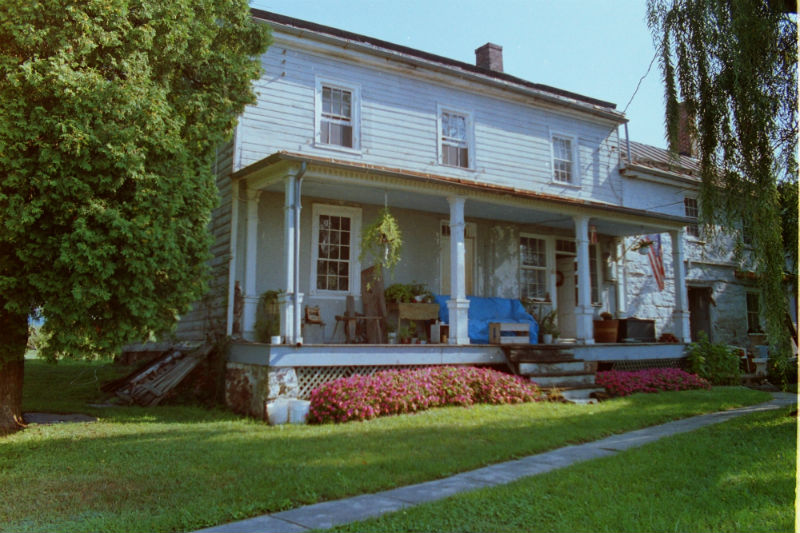Take a moment to peer into the window of the over 36 year of Douglas Claytor, a Maryland resident, a preservation advocate, and a skilled preservation practitioner and teacher. Doug’s had a hand in many of Maryland’s great restoration projects – and he’s committed to share his knowledge with the next generation of preservationists.
[NICHOLAS REDDING] Welcome to Preservation Maryland’s PreserveCast. I’m your host, Nick Redding. Today, we’re peering into the world of historic preservation through its very windows. Doug Claytor is our guest today, and he’s an expert on historic window preservation, and has worked on fascinating projects all across our state. Doug shared with us the inside scoop on some of the many projects he’s worked on, including at the Cozy Restaurant at Camp David. He also shared his views on some of the more exciting issues in historic window preservation, like lead paint, and environmental and energy saving concerns, as well as the future of historic preservation work as a profession. Doug is a man with a lot to say, so let’s dive right into Preserve Cast.
And be sure to subscribe on Apple iTunes or the Google Play Store.
[INTRO] From Preservation Maryland Studios in the historic podcast district of Baltimore, this is Preserve Cast.
[NICHOLAS REDDING] Doug Claytor is a historic preservation craftsman and instructor in historic preservation trades, including carpentry, masonry, plastering, painting, and historic material disassembly and salvage. He has over 36 years of experience in working on and with old buildings. Based out of Frederick, Maryland since 1977, he’s worked on many historic buildings in Maryland, Pennsylvania, and Virginia. Recently, he’s been focusing on historic window restoration, including overseeing a class that Preservation Maryland helps sponsor on window restoration given at the Thurmont Historical Society in Thurmont, Maryland. Currently, Doug is working on the exterior restoration of the Camp Cozy cabin in Thurmont, Maryland. Welcome to PreserveCast, Doug.
[DOUGLAS CLAYTOR] Thank you for having me. Appreciate being here.
[NICHOLAS REDDING] So you have been at this for quite a while. Tell us a little bit about yourself. I think it’s interesting for people to understand sort of what brings people to preservation. How did you end up really having a career in historic preservation?
[DOUGLAS CLAYTOR] Well, I guess it stems back about three generations. My grandmother planted the seed in me when I was very young, the history seed. She would tell us about her family background, and that eventually evolved into genealogy. But it was a fascinating time for me as a small child to hear her descriptions of travels in America when transportation wasn’t what it is today.
[NR] Now, was she from Maryland?
[DC] No, she was from Virginia, down in Orange County, Virginia. And she would talk about traveling over the mountains in Virginia in an old hupmobile that had a hand-crank starter. So that really takes it back back to the early days of motoring. And those were the kinds of things that she told me about. But as I got older and my grandparents were still able to travel, they took me to historic house museums in Virginia, and in Maryland, and really got to talking about old buildings in general. It was something that as I got older and I went into the workforce, I decided that was what I really wanted to do was to work on old buildings.
[NR] And so, is that how you started? That was the beginning of your career?
[DC] In old houses. I was — a navy veteran. And I spent time in the US Navy Seabees. And I learned construction trade skills at that time. I went in as a plumber, and when I got out of the navy I went to work as a plumber for plumbing companies. And did that for a couple of years, and learned an awful lot about construction and new construction, civilian construction, much different than government construction that I was familiar with.
[NR] I bet.
[DC] I was able to decide that plumbing although something that was very useful and would be good for me, people really didn’t care what it looked like [laughter]. They only wanted to know whether it worked or not [laughter]. And I wanted to do something that was to be seen.
[NR] So what was your first true preservation project that you worked on?
[DC] Well, in Frederick, I left the plumbing trade. I gave my employer about 10 minutes notice, and I said, “I’ve just been hired by a man who restores log cabins.” And I went to work for a man in Frederick at Everedy Square. And I went to work with Richard Guynn, and we disassembled and moved and reconstructed a log building there on Shab Row project there. That was my first real experience in carpentry, working with carpentry skills.
Rich is an excellent carpenter and excellent teacher and one of my mentors. I spent two years working with Richard, and then I ventured out on my own. And I formed a company, or at least I got a home improvement license in the name of Renaissance Restorations. And I owned that company for 15 years and took on a lots of different projects in Frederick City. Particularly buildings of note that I worked on and had a hand in are Scheifferstadt Architectural Museum. I restored the 18th-century cooking fireplace there that was a really exciting early project.
[NR] And for those listeners outside of Maryland, Schifferstadt is a historic house museum in the City of Frederick, Maryland, sort of in the center of the state, and is a phenomenal early Germanic colonial structure. Schifferstadt, the name coming from, can you give a little background on that?
[DC] The name Schifferstadt comes– the man that built the house was Joseph Bruner, and he came from the town of Schifferstadt in Germany.
[NR] Which is today the sister city of Frederick, right?
[DC] Indeed it is. That is correct.
[NR] Wonderful. So you worked on Schifferstadt, which–
[DC] Schifferstadt was just one.
[NR] Everybody in Frederick knows Schifferstadt.
[DC] And one of my early projects with Renaissance Restorations was the Barbara Fritchie House. Actually it was the Hauer House, right next door to the Barbara Fritchie Museum there in Frederick. And the Hauer House was the maiden home Barbara Fritchie. Her maiden name was Hauer, and she grew up in that house and spent her life there.
[NR] And again, just a little bit of background for those people listening from outside of Maryland, Barbara Fritchie – which is, at least in Frederick and in other parts of Maryland, sort of a household name – supposedly, unfurled a American flag when confederate General Stonewall Jackson was coming through town in 1862 and leaned out of her window and shook her fist at him and said, “Shoot if you must, this old gray head but spare your country’s flag!”
And actually just last night, I was at an event hosted by the Ausherman Foundation, and they’ve just paid for a documentary on Barbara Fritchie. You can go to barbarafritchie.org, and you can watch the documentary about her. So pretty neat. There’s some debate on whether or not that happened, because she was 95 at the time. But there was a poem written by John Greenleaf Whittier about Barbara. And obviously you had a hand in restoring that structure.
[DC] Indeed. It was very exciting. This was an early window restoration project for me. When we took the sash out of the openings of the windows, and we removed all of the paint, we took all the glass out of the sash. We had made repair to the sash. Reglazed all of the windows and then repainted, and then we dealt with the jams and the other aspects of the facade of that building.
It was a pretty good project. Lasted for about a year or so, because after we did the windows, then we took on the shutters. And if anybody’s ever had a hand working on shutters, you know how lengthy that process can be. In that particular case, we took and disassembled each shutter and stripped each louvre individually, and then reassembled and strengthened it.
[NR] Wow. And someone was willing to pay for that?
[DC] Yes, oh yes.
[NR] That’s a phenomenal property owner [laughter].
[DC] It was. the owner of the Barbara Fritchie Museum as well. That was a real good project for me. I enjoyed working on that. But I also worked on the Historical Society of Frederick County. Restored the back porch on that. That took about eight months of some very serious work involving different disciplines that I really hadn’t had but had to learn in the process of doing the work with epoxies and other consolidants that help to take care of rotten wood. That was a big first for me.
[NR] And so you’ve described a lot of structures from the early and mid part of the 19th century. But you’ve had a hand, I presume, in some 20th century structures as well?
[DC] Yes. I have to think about that [laughter].
[NR] Because I guess the one we mentioned, Camp Cozy, right, that’s the most recent one.
[DC] That’s the one I’m currently working on. It was built in 1929. The Cozy Cabin, of course, is the sole surviving intact structure. Well, there might be a couple of them that were moved earlier–
[NR] Somewhere else.
[DC] –and are used as out buildings in Thurmont somewhere. But it was part of the Cozy Restaurant Hotel which was torn down this past year.
[NR] A big loss.
[DC] And a lot of history was lost in Thurmont. But this particular building was intact and it was small enough, about 10′ by 15′ or so.
[NR] That’s real small.
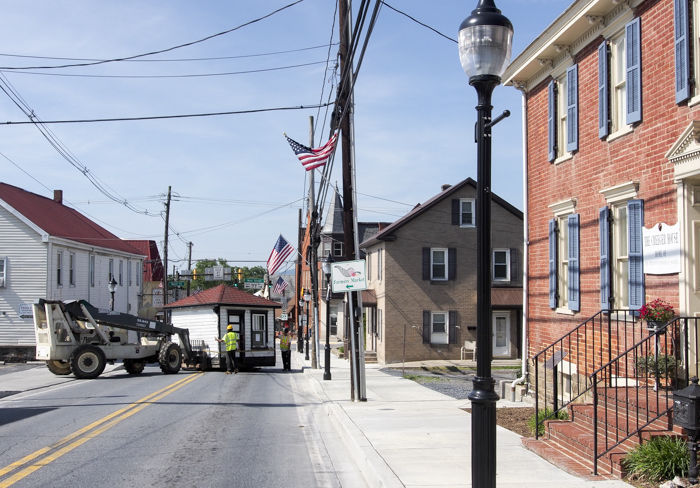
Moving the Cozy Cabin. Photo by Russell C. Poole.
[DC] And it could be picked up in one piece and so the demolition contractor graciously moved it up to the property of the Thurmont Historical Society.
[NR] And this is a motoring cabin so this is from the early days of motoring across the country. This was sort of a roadside hotel that grew into a restaurant and sort of a little mini-empire there in Thurmont.
[DC] It was.
[NR] And for folks outside of the state, Thurmont is also home to Camp David or probably at the time when all that was constructed was known as Shangri-La which is sort of the —
[DC] Earlier name of —
[NR] –mountain home of the president.
[DC] President Roosevelt, FDR, started the Shangri-La, and President Eisenhower named it Camp David after his grandson David.
[NR] And so that’s sort of Thurmont’s place in history.
[DC] Indeed, it is.
[NR] And there was a lot of people traveling through that area because of that as well.
[DC] And many historical figures of note certainly dined at the Cozy Restaurant, and people like Winston Churchill and other notables that, of course, in more recent times when they had the Camp David Accords. Cozy was the center of information being disseminated.
[NR] So your involvement in preservation really has spanned everything, it sounds like, from French and Indian War all the way to Winston Churchill [laughter].
[DC] I have worked on–
[NR] You’ve touched quite a bit.
THE BEATTY-CRAMER HOUSE
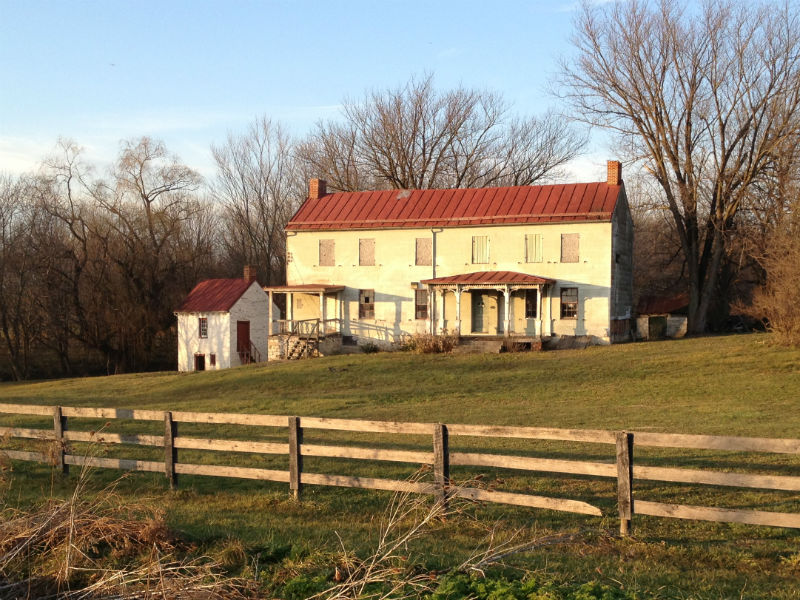
[DC] –some of the earliest buildings. One of the buildings I’ve been involved with that really is of historic note is the Beatty-Cramer House just outside of Frederick. It was a Dutch built timber frame that probably dates into the 1720s. We really don’t have a hard and fast date on its construction, but it is a one of a kind style of architecture in Maryland. We don’t have Dutch architect timber frames here.
[NR] Not a whole lot.
[DC] No, we’ve got a lot of log buildings and other ones, masonry, but not like this one. And so we’ve been involved with that for over, I don’t know, 25 years since we first discovered it’s importance. And as far as preservation is concerned, it’s still here today because we found it.
[NR] And this is Frederick County Landmarks, a local preservation group.
[DC] Yes, Frederick County Landmarks Society that – Foundation actually, that owns the building now and has been its steward since we were able to rescind a death sentence for it. It had been planned to use it for practice for a fire department.
[NR] Which so often, unfortunately, is the case.
It does happen but we were able to – and with Mr. Joe Lubozynski, who’s inquisitive mind wanted to know more about what made this building tick, and he got permission to go in and we found some very interesting rare items like casement windows in the building, which are unheard of here in Maryland.
LIVING IN HISTORY: RESIDENT CURATORSHIP PROGRAM

[NR] So now, you – and I know this because I follow you on Facebook and you’re prolific in the postings about the beautiful place in which you currently live. And it’s a unique program, as well, from what I understand, that some people even within Maryland and certainly from outside of the state might not be familiar with. Where do you live? And what’s the interesting relationship there?
[DC] Well, I live with my significant other, my girlfriend Michele Smith, who is, in fact, the resident curator of the property. She started the project of restoring the historic Widmyer House before I came along, before she knew me, with her ex-husband. And they did a lot of work to the building prior to their marriage going south. And I must’ve looked very attractive to Michele because I knew how to scrap paint [laughter] and do windows and restore buildings.
[NR] Right, and so now Resident Curatorship for those that don’t know, this is a property that’s actually owned by our state Department of Natural Resources. And our DNR, like has many natural resource agencies, has more historic properties than they know what they do with. And so you can apply to be a curator and actually live in this property rent and mortgage-free but you in exchange, you take on the onus of restoring and caring for this historic structure.
[DC] Yes, that’s correct.
[NR] And this one is out in western Maryland.
[DC] At Fort Frederick State Park.
[NR] Big Pool, Maryland.
[DC] Yes, in Big Pool. Washington County. It’s a gorgeous place. And the house has about four and a half acres associated with our curatorship but it adjoins the 1,000/1,500-plus acres of Fort Frederick State Park. And it’s a lovely place, really, for us to live because we take advantage of the walking trails throughout the park. And it’s located right alongside the C&O Canal and the Potomac River. It’s a lovely location.
[NR] And for those who are interested, the Curatorship Program actually has a number of properties that are available right now. So if there’s someone listening who wants to take on one of these projects, there are projects out there for you to take on.
[DC] I would talk to Mr. Peter Morrill at
[NR] Department of Natural Resources.
[DC] — DNR. And he can certainly – he can put you in a place. He can find you something, particularly if you want to get your hands dirty.
SUGGESTIONS FOR THE DIY PRESERVATIONIST
[NR] And now, so speaking of getting your hands dirty, a lot of people shy away from doing a lot of these projects themselves. Obviously, you have a long experience, so the idea of going in and tearing out a window and popping it out of the sash, taking it out of the wall and completely redoing that window that obviously doesn’t scare you, you’ve done that many, many times. It’s sort of old hat.
But for someone who is not familiar with that kind of technology, and is maybe a little concerned, or thinks they couldn’t do that, is there any advice for them? Would you say that they could do it?
[DC] Yes, I would say, well, “Be brave, and be prepared to have it be a long, drawn-out process.” Having to reinvent a wheel or having to learn something on your own is difficult. It’s certainly possible, and it was that way with me. I didn’t really have any one particular person that could really teach me the nuts and bolts of doing the work with windows and with paint removal, which I see as the biggest single hurdle to historic preservation.
I was able to just dig in and start to work on these windows, and in the course of doing hundreds of historic window sash, you learn all about products and materials that are available and what’s – you know, the work practices that the general populace employs to do this work. And that can be an issue with historic preservation.
[NR] Right. But, I guess, you would suggest then, sort of what you did with Preservation Maryland [Historic Window Workshop, Thurmont, September 2016]. Maybe if you’re interested in doing this taking a class…And there are a number of classes out there, oftentimes they’re either free or just a few bucks. But that, it sounds like, is learning from someone else’s mistakes, I guess [laughter].
[DC] Well, it certainly saves a lot of time and heartache and failure. Because, indeed, I experienced all of those. But once the voilá moment came when I developed a technique for removing paint that did not do any damage to the historical material – because many, many times people damage the fabric just trying to get the paint off.
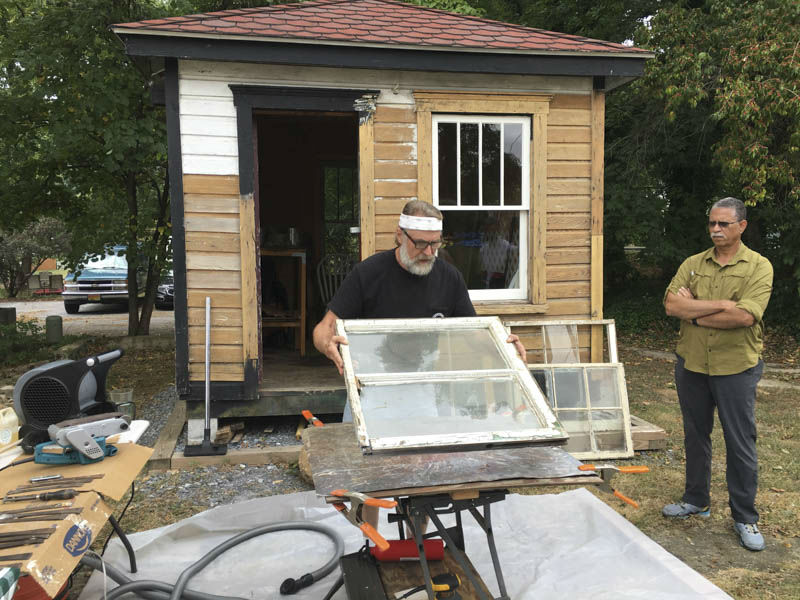
Douglas led a window workshop for Preservation Maryland at the Thurmont Historical Association, 2016.
[NR] Right. Just trying to get the paint. And also, people are scared and worried about lead paint, and lead paint getting out.
[DC] The lead paint issue, for historic preservation, is very serious. It’s also very serious in all the rest of our built environment from prior to 1978 when they passed a law and disallowed lead in paint. But, due to the fact that it’s all over in our environment, it is something that we really need to be aware of. And the process of removing it has to be done in such a fashion as to protect not only the worker who is doing the work but also the environment that it’s done in.
[NR] Right, you don’t want to just spray lead paint flakes and –
[DC] Dust – dust all over the place. Dust is the biggest, biggest concern. And I’m of the opinion that a lot of this could have been avoided had we spent a bit of time being more fastidious in cleaning these houses. If people were taught cleanliness skills, how to really clean, the failing paints wouldn’t have been such an issue because they would’ve been cleaned regularly with the window sills – and cleaning in general. I don’t think people have been taught how to clean [laughter].
[NR] Cleaning is a preservation skill.
[DC] It is. It’s a paramount preservation skill. And you learn how to keep it clean, everything else follows suit including the work that you’re trying to do.
[NR] So lead paint alone shouldn’t be a reason someone should be scared of saving a historic window.
[DC] Indeed. Because it can be removed and it can be captured when it’s generated. When the lead paint is being scraped, I use a HEPA vacuum cleaner right over the scraper. And as I’m scraping, the paint chips go into a self-contained unit that can be properly disposed of. That’s not 100% fail-proof, I mean there’s still a small percentage of paint that gets out into the work area.
But in regularly cleaning that every day, I’m not as particular or fastidious about the type of protections that we need with our clothings – working in Tyvek coveralls and things that protect the worker completely from any lead dust. If in the process of removing this, you capture it at generation, it doesn’t get into the environment and it doesn’t get all over the worker. So that’s a work practice that really needs to be addressed. And in seeing it in actual used out in the field, it’s abhorrent what I see happen. Even though people have been educated in the dangers of this, the shortcuts that people take in the process are very detrimental to the environment and to themselves.
[NR] So it’s important to be safe…
[DC] It is, but how you are safe. But you still have to get the work done. And if it’s 95 degrees on a Baltimore afternoon and you’ve got two weeks to get this done, you really can’t get the work done in that environment. That’s been my personal experience with dealing with the issue.
MAKING HISTORIC WINDOWS EFFICIENT
[NR] Let me ask you something else about windows. I mean, one of the other things as far as technology is concerned, and in that sort of what we’re looking at with this series of podcasts for the intersection of technology and historic preservation, and that could be defining in a lot of different ways.
We just did an interview on drones, and now we’re talking about sort of a more basic but a very important technology like windows and the actual artistry and craftsmanship that goes into caring for those which is a technology in of itself – well, they’re sort of – maybe use the term, suckered in, by window salesman and people who wanted to make the case that these new vinyl windows, they’re going to save you so much money.
And the data is there that shows from a return on investment that you’re going to see very soon. And it costs a lot, and you lose a lot of character associated with the building. But one of the cases that they make is that, “Well, there’s no way to make a wood window as energy efficient as a vinyl window could ever be. And also, they’re so warm and comfy, and you won’t have any drafts.” But obviously, we know as preservationists, that’s probably not the case, that we can do that with wood windows. Have you done that before?
[DC] Indeed.
[NR] Have you weather stripped and all those sorts of things?
[DC] Indeed. Weather stripping is a key factor to historic wooden windows. Storm windows, both exterior and/or interior, storm windows really can make that window as energy efficient as a vinyl window, according to their specifications. But I want to say something that I think America’s been sold a bill of goods on these replacement windows and the energy efficiency that is lost in a historic drafty old window.
Yes, when a window has been allowed to deteriorate and doesn’t receive maintenance, and the glazing’s falling out and windows panes are cracked, and other aspects of an old window that really has been neglected for a long time. Yes, it loses its thermal efficiencies, but I’m also a believer in fresh air.
Now fresh air when you’re paying for a heat and electric bill kind of flies in the face of the economy of it, but I think that I have – I can speak from the experience of the last 10 years in the historic Widmyer House with no storm windows, and wooden windows that have been restored but without weather stripping, that function freely and frictionless basically in their openings, that they allow a significant amount of air into the building for fresh air. We know that a too-tight of an environment can trap illness and disease, dust in particular, and mold and other things.

Doug Claytor and Michele Smith at an open hearth cooking demonstration.
[NR] Right. I actually talked to someone – interesting you bring this up. I was talking to someone who builds new homes, and new homes are being built so tight now that they actually have to have air exchange units added, and they have to by code [laughter], because they’re so tight they literally encapsulate the building. We’ve gotten to the point where we’ve made everything so tight now we actually have to have a mechanical unit to bring things in and out…you don’t need that at the Widmyer House.
[DC] No, not at all. And in fact we burn wood, we have a wood stove for our primary heat.
[NR] Do you chop the wood yourself?
[DC] Oh yes.
[NR] So it heats you twice.
[DC] When you load it, unload it, bring it in the house, haul out the ashes. There’s a lot to that, but it’s a way of life that I’ve lived down for over 30 years. And as long as the good Lord permits me to be able to cut my own wood and do that work, I will because it’s a wonderful way of living and I have been very healthy, I have been blessed with good health, we don’t get sick, we don’t have respiratory illness unless one of the granddaughters brings it from the elementary school [laughter]. That’s just the way we get sick. But not from drafts or anything like that. And we’re very fond of wool blankets. A lot of covers never hurt anybody.
[NR] So you lead a historic life not only in the buildings you preserve, but sort of the way of living.
[DC] Oh yes, indeed. Michele and I, Michele Smith, my girlfriend, and I practice living history, and we do open hearth cooking demonstrations from the 18th century. Cooking over the fire is something that I just love to do and have done ever since I was in the Boy Scouts back as a youth.
PHOTO OF WINDOW RESTORATION AT WINDMYER HOUSE
[NR] So we’ve talked a lot about windows because I mean, that’s sort of a hot-button issue, it’s sort of the eyes of a house, and increasingly, we see them being lost and we really feel like something as an organization is lost when those are gone. And we’ve talked about how that’s definitely something average homeowner can tackle, take some classes, learn your hand at it.
If there was one preservation skill that you would suggest would be sort of the first thing someone should learn, though, is it windows? Or what type of preservation project would you say if someone wants to get their hands dirty and they want to try something out?
[DC] A historic window.
[NR] You would do windows?
[DC] Or a door. And that could be removed from the building. I would start with one at a time even though you might have 30 windows that need to be done.
[NR] Don’t pop them all out.
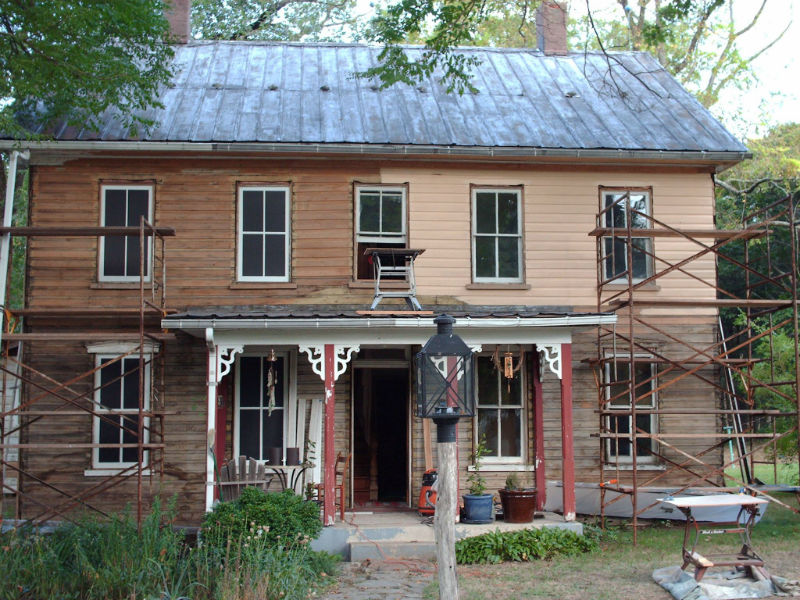
Can you tell which windows at painted plywood? Photo by Douglas Claytor.
[DC] Do one [laughter]. One thing I do at the Widmyer House, I had to take a window out last week. We had a tree limb come down and sent a branch through one of the windows. And I had to replace the broken window. I took the window sash out, and I had a piece of plywood painted to look like a window. It was just a plain piece of plywood that fit the opening. When we first started the project, I did four windows like that, and I painted four faux windows on the plywood. And that plywood migrated all the way around. We took four windows out at time.
[NR] That way you don’t have to rush through it in a day.
[DC] Oh, indeed.
[NR] You can just take your time and do it right.
[DC] And that can be weather-stripped. You can use foam weather stripping around that plywood in the winter time. And I strongly suggest it. You can the project through the winter with that. And the painted plywood adds a degree of professionalism to the appearance of the project. Nobody wants to see a boarded up window, a plywood window, on any building – just doesn’t read well. And no one can tell the difference with that painted black and the white outlines of the window sash painted white, and it only takes a few hours to do that.
TRAINING THE NEXT GENERATION OF PRESERVATIONISTS
[NR] So let me ask you, you’ve been at this for quite awhile. You’ve seen the preservation movement change and grow and do some good things, probably do some bad things. With respects to the craftsmen who do this, of which you are one. Do you feel, and many do, or is this wrong to think that we have fewer craftsmen among us? There’s sort of this sense that we’re losing these skills and these trades. Is that something that concerns you? Do you feel like there’s enough people to replace those?
[DC] My biggest concern, Nick, it really is. I’m 62 — I’m 61, okay, I’m not two…
[NR] Let’s not get ahead of ourselves [laughter].
[DC] — 61. And the average age of a bricklayer today was 58 the last I had heard, a number of years ago. Skilled tradespeople in this country are not being replaced by a younger generation. That is a big cause of concern because who’s going to do the work? We can import our labor force, which this country has done for a number of decades since we’ve given up on the apprenticeship programs in this country, and it’s cost us dearly.
We do have many skilled craftsmen and many people who are concerned with this issue. I’m a member of the International Preservation Trades Network, or PTN, and I demonstrate window restoration for two years now at their international workshop that they hold once a year. And people from all over the world and the country come and see what the latest preservation craftspeople are doing and the products they are using and the methods. It’s very educational and that information is then disseminated across the land. We need much, much more of that in a localized area.
[NR] Well, I can tell you that Preservation Maryland, actually, is working on a apprenticeship program. We’re trying to work with a group out in Catoctin Furnace in Frederick County, Maryland, that’s interested in getting at-risk youth involved in learning preservation trades and kind of giving them a certification, so we definitely share your concern.
[DC] I’m familiar with that group, as well. I spent some time this past year — one of the buildings that was part of the Cozy Restaurant was what they call the miner’s cabin, that originally was constructed back when the Catoctin Furnace was still in operation and had –
[NR] Right, and it was supposed to be a temporary structure, right?
[DC] Very temporary structure. And it was–
[NR] And somehow it’s last over 100 years almost?
[DC] In 1929, a Mr. Wilbur Freeze, who started the Camp Cozy, picked this building up and hauled it up a couple of miles up into Thurmont and then repurposed it as a rental cabin for camp Cozy. And it went through many incarnations in that place.
- Secure pule of salvaged materials. Photo courtesy Douglas Claytor.
- Deconstructing the Miner’s Cabin. Photo courtesy Douglas Claytor.
- Silver Oak Academy student. Photo courtesy Douglas Claytor.
- Deconstructing the Miner’s Cabin. Photo courtesy Douglas Claytor.
[NR] Right, and then you deconstructed this with the help of students from the Silver Oak Academy?
[DC] Of the students from the Silver Oak Academy. And my whole effort there was to instruct them on the disassembly of historical materials or materials in general so that those materials could then be utilized again. We pulled every nail from the cabin and oh, boy, it had three or more layers of materials that had – whenever they wanted to remodel they just added another layer to the building. And we had to systematically disassemble those layers and then pull the nails and there were buckets. We’ve got three or four, five-gallon buckets from this small building of nails. I couldn’t believe how many fasteners had been used.
[NR] But these students enjoyed the experience?
[DC] They did and it was so foreign to them. And the students that attend there are residents from inner city Baltimore. And have had run-ins with the law, and they’ve been given an opportunity to turn things around.
I strongly support the program because I think we’ve got to really target those individuals, but those young guys were no different than any of the young people that I would see in any high school today.
[NR] Right, and I think the positive takeaway from that though is that, if given the opportunity to do this kind of work, they found it fascinating and many of them want to continue on with it. So, I think that the lack of craftsmen is something that we can tackle as a preservation movement, but we have to be serious about it.
[DC] And education is the key. We’ve got to teach those, and that requires having hands-on knowledgeable people that can lead the instruction.
WHAT’S YOUR FAVORITE BUILDING IN MARYLAND?
- Wolf’s Delight interior with Judith Candela. Photo by Douglas Claytor.
- Wolf’s Delight near Woodsboro, Maryland. Photo by Douglas Claytor.
[NR] So, as we sort of draw to our conclusion here, this will be a difficult question. It’s a difficult question for everyone that we interview, but do you have a favorite Maryland building? That’s tough – 37 year long career restoring places and you’ve seen a lot, but is there something that stands out as just a really special place that you found to be really just fantastic?
[DC] Well, one in particular is very near and dear to my heart, and it is one that I invested a great deal of my time and energy on – the historic name of the building is Wolf’s Delight. It was an 18th-century log house and farm that was located near Woodsboro, Maryland on a gravel quarry. And the gravel quarry is expanding their operation, and this 18th-century gem of a building and farmstead was in the middle of it. And so I had to make a decision. Was given the opportunity to move these buildings, and so I made the decision to do it. And it took four years of my life to pull every nail and move every board. And we saved every – when I say every material, we saved every material.
[NR] Is it still standing today?
[DC] No, it is standing in piles in safe storage.
[NR] To be continued?
[DC] To be reconstructed at some point in time. It’s not only a favorite. I really hate to walk away. I’ve been away from that building and project for 10 years now or more. And I really hate to walk away from the amount of effort that I put into that, and because we have all of the materials, each and every trade could be represented in the reconstruction of that. And I want to use that entire project for education.
[NR] So if someone out there is listening and they want to reconstruct a historic structure, you have just the place for them.
[DC] And it’s a beautiful location on the banks of the Monocay River in a large field and lots of room around it. And when it goes back together–
[NR] That’s the optimistic preservationist in you.
[DC] Well, God willing and the creek doesn’t rise too much [laughter] because it’s next to the river.
LEARN MORE FROM THE CLAYTOR HISTORIC PRESERVATION INSTITUTE
[NR] So, speaking of restoration rehab work, if people want to get a hold of you, if they want to talk to you about a project or they want you to come out and do a training for them, how can they get a hold of you? Is there a way for them to find you?
I have, as you’ve mentioned previously, I’ve become quite prolific on Facebook and I can be reached through Facebook. I also have a secondary site on Facebook called the Claytor Historic Preservation Institute which, I hope, will develop into this place where people can come and learn and take away and go then back and then do their projects.
[NR] So you can teach an old preservationist new tricks? You’re on Facebook, they can find you there.
[DC] It was tough.
[NR] It’s tough, but you’re good at it now.
[DC] Well, I’ve spent about three years now, online, and prior to that it was hammer and nails. And it’s been an exciting ride and I love my camera.
[NR] There we go. Well, Doug, it has been an absolute pleasure to have you with us. Thank you for joining us today and thank you for everything you’ve done to preserve Maryland’s unique and irreplaceable heritage.
[DC] Oh, thank you. Thank you very much. Appreciate being here.
CREDITS
You don’t need to open a history book to find us, and available online from iTunes Store and the Google Play Store, as well as our website, presmd.org. This is PreserveCast.
This podcast was developed under a grant from the National Center for Preservation Technology and Training, a unit of the National Park Service. Its contents are the sole responsibility of Preservation Maryland and the Maryland Milestones Heritage Area and do not necessarily represent the official position or policies of the National Park Service or the National Center for Preservation Technology and Training.
This week’s episode was produced and engineered by Ben and Stephen Israel. Our Executive Producer is Aaron Marcavitch from Maryland Milestones Heritage Area.
Our theme music is performed by the band Pretty Gritty. You can learn more about them at their website, prettygrittymusic.com, on Facebook, or on Twitter @pg_prettygritty.
To learn more about Preservation Maryland or this week’s guest, visit preservationmaryland.org. While there, you can check out our blog and learn about what’s current in historic preservation. We’re also on Facebook, Instagram, Flickr, and Twitter @preservationmd. And of course, a very special thank you to our listeners. Keep preserving.


